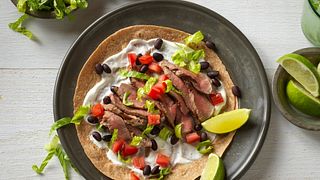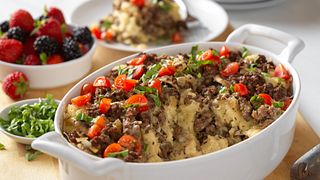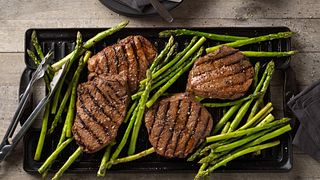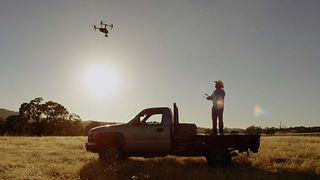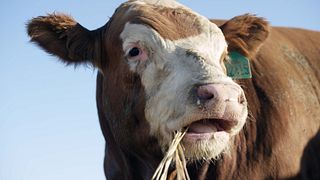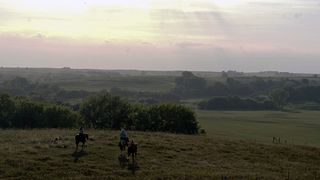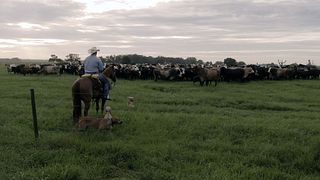Animal care and safety at the feedyard
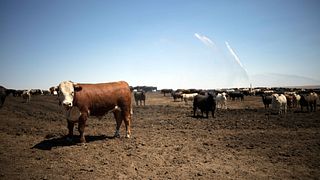
After the cow/calf and backgrounding phases of the beef lifecycle, cattle spend roughly 4-6 months in a feedyard. Like all segments of the beef industry, feedyards take great pride in the care they provide for the animals and the environment. Here cattle are free to graze at feed bunks containing a carefully balanced diet, have plenty of space to stand, lie down, socialize and move.
Learn about what happens at a feedyard and how safety and care are always a priority.
Experts on Site
Veterinarians, nutritionists and cowboys on horseback called pen riders, work together to look after each animal at the feedyard. Everyone at the feedyard is responsible for ensuring that the cattle are cared for through such things as access to fresh food and water and safety from injury and disease. One of the best ways to do this is to limit the animals' stress and anxiety while at the feedyard.
Pen riders ride through the pens, monitoring cattle health, well-being and safety. They ensure that each animal is eating and drinking water and showing no signs of illness. These riders practice low-stress cattle handling techniques to move cattle around the yard and pens.
Veterinarians are frequently onsite to promote animal well-being and wellness in a variety of ways by both monitoring cattle and training handlers to look for signs of illness. Feedyard employees and cattle caregivers are often trained by veterinarians on animal health, proper care and handling. The veterinarian works with these caregivers to look for symptoms when the animal isn’t feeling well, making sure staff is up-to-date on regulations and administering health care techniques.
When it’s determined an animal isn’t feeling well, a feedyard employee or veterinarian will do a health assessment on the animal including taking its weight, temperature and performing other health checks. From here, the veterinarian or cattle caregiver will determine if the animal needs further treatment, additional observation or if it is healthy enough to return to the herd.
Nutritionists also play a vital role in the procedures at a feedyard. While at the feedyard, cattle are given a specially balanced diet to optimize the animal’s health, as well as beef production, all in an efficient and sustainable manner. Nutritionists work to formulate diets with the right mix of protein, carbohydrates, vitamins and minerals to help each animal grow. Nutritionists also work with the feed truck operators to ensure pens are receiving the correct amount of feed and that the cattle are eating the feed in a timely manner to ensure fresh, palatable feed is available each day. Feed truck drivers monitor and report how much a pen has eaten and work with the nutritionist to make adjustments if needed.
Animal Care and Health
The beef industry has a long-standing commitment to providing a safe and comfortable environment for cattle. At the feedyard, animals are cared for around the clock based on their individual needs and the overall herd health plan. This includes monitoring, providing plenty of space to roam, eat and drink water at their own convenience. This could also include vaccinating cattle to prevent disease, treating cattle to prevent or remove parasites such as flies and treating animals with antibiotics to help prevent, cure or treat a disease.
Cattle are provided with adequate space for comfort, socialization and environmental management. The pens are cleaned regularly including manure and mud removal, and dust control. In hot areas, feedyard managers often spray water on pens to keep the dust down and keep animals cool. While keeping animal safety and welfare in mind, it is important for feedyards to balance dust management with environmental stewardship by using natural resources carefully.
The beef industry has a long-standing commitment to providing the public with the safest beef possible. The Beef Quality Assurance (BQA) program is a voluntary, industry-developed program that provides farmers, ranchers and feedlot managers with the resources and education on proper cattle management techniques. Learn more about how the BQA program helps guide the beef industry.
Diet
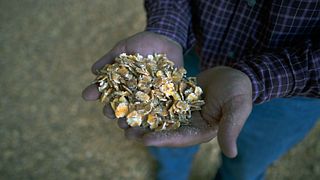
Cattle in feedyards are fed a formulated diet consisting of roughage such as grasses and hay, grains like corn and oats, vitamins, minerals and sometimes local renewable feed sources such as citrus pulp, brewer’s grains and almond hulls. A balanced variety of these feed ingredients are used to help optimize cattle nutrient needs including protein and energy to support the natural muscle building ability of cattle to produce lean beef. While cattle may consume larger amounts of grain in the later stages of finishing, they are still receiving several pounds per day of forages such as grass hay, silage or alfalfa. Learn more about the differences between grass-finished and grain-finished beef.
Using balanced diets also minimizes the impact on land use, water use, and other resources needed to provide affordable beef for a rapidly growing population. Unlike humans and other animals, cattle can consume by-product feed and upcycle them into high quality protein. These products could include citrus pulp, brewer’s grains and almond hulls as well as, potato by-products, soybean hulls, cornstalks or other by-products that are considered waste. Incorporating these otherwise unusable feedstuffs into cattle feed, results in a sustainable practice that helps upcycle byproducts into protein to help feed a growing population.
